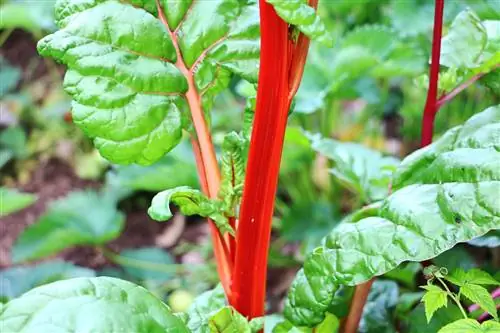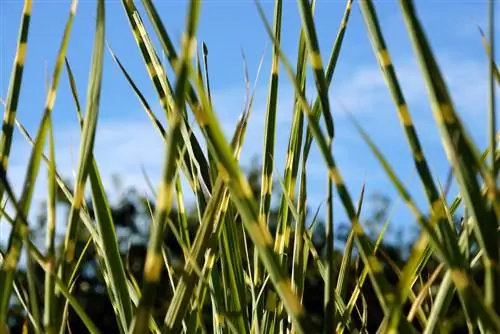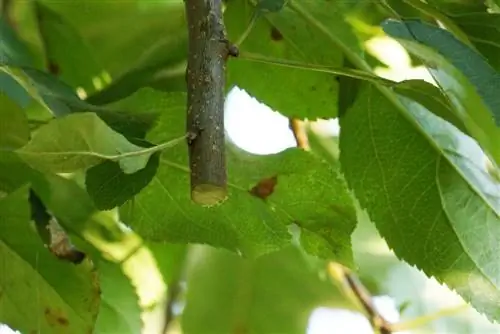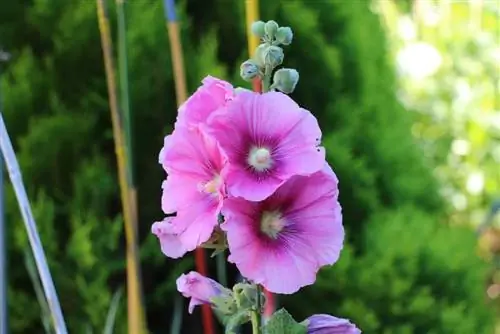- Author admin [email protected].
- Public 2023-12-17 03:39.
- Last modified 2025-01-24 12:45.
Rhubarb or Rheum barbarum, as it is called in botanical terminology, is a stem vegetable and a permanent crop. If it is well cared for, it can easily spend a whole decade in the same location and even increases in yield. Provided that some crucial points are taken into account when it comes to culture. This also includes the offcuts after the harvest.
Harvest
Rhubarb can be harvested very early but not for long. Traditionally, the harvest season ends on June 24th. Another sign of the completion of the harvest is the formation of flowers. The reason for this is not that it is anchored in traditions - but that the oxalic acid content increases significantly afterwards. Although this also occurs in other vegetables and fruits, it is harmful to he alth when consumed in large quantities.
In addition to the time limit, another point should be taken into account when harvesting rhubarb: the harvest quantity. One to a maximum of two thirds of the stems should be harvested. Otherwise the plant will be weakened too much. The leaves and upper and lower stem ends can be cut off and left directly on the bed or worked into the soil. They serve as a natural green fertilizer for rhubarb and reduce the effort involved in adding additional nutrients.
Tip:
When harvesting, the stalks should not be cut off, but twisted.
Fertilization

So that rhubarb can deliver high yields and can easily cope with cutting, it needs the appropriate nutrients. As a heavy feeder, it should be well fertilized anyway. However, if it is to be harvested regularly, the amount of fertilizer must be increased again.
Experience has shown that around three to five liters of mature compost should be mixed with around 100 grams of horn shavings per square meter and worked superficially into the soil around the rhubarb in the substrate. This nutrient is added at the first shoot of the year, i.e. around March. To do this, the plants should be watered thoroughly so that the fertilizer can be distributed evenly.
Further fertilization takes place after the end of the harvest in June. Recommended remedies are then:
- Plant manure
- Vegetable fertilizer
- Compost
- the leaves and stem remains of the rhubarb
Flower stems
When the rhubarb forms flower stalks, it uses a lot of strength to do so. The plant does not put its energy into the reserves necessary for overwintering and thus into the production of new yields, but into reproduction. This can and should be stopped if no seeds are to be obtained. For this purpose, the flower stalks are twisted out or cut out. In order to protect the plant's reserves, the measure should be carried out as early as possible.
Blend
As mentioned, not all of the rhubarb should be harvested so that the plants' reserves are not reduced too much. For this very reason, cutting immediately after harvest is not recommended. Unfortunately, it is still common practice to cut off all stems close to the ground as soon as they can no longer be harvested.
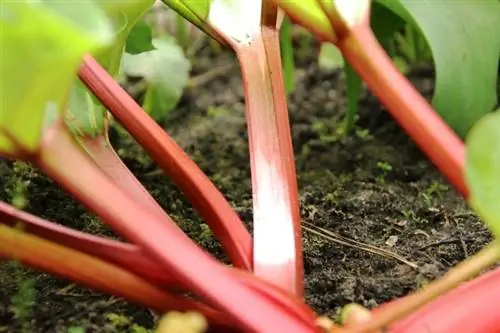
However, it is gentler on the plant and more beneficial for the next harvest not to shorten the still green, vital shoots. Only wilted and dead stems are removed. This measure can be carried out either in early spring or in autumn. It is a little safer to cut the rhubarb in the fall. This means there is no damage to the new shoots. In January or February it is also still possible to remove dead leaves and stems from the rhubarb.
Tip:
The rods should, if possible, be unscrewed instead of cut. In this way, there are no residues left on the plant that could rot or mold later on.
Implement
The rhubarb can remain in the same location for around ten years. This is rather unusual for a heavy feeder, but with the right fertilization it is certainly possible. It should then be moved or a new plant grown in the new location. Again, leaves and stems can remain directly on the bed or be incorporated into the soil to distribute nutrients more quickly. Relocation can take place before budding in spring or autumn.
If space in the bed is limited, a raised bed can be the solution. Here it is enough to completely change the soil or at least the upper layers in order to be able to plant the rhubarb again in the same place or another heavy feeder.
Diseases
Rhubarb is a robust plant that is rarely affected by diseases. However, leaf spot disease and the so-called mosaic disease can occur. The leaf spots are brownish discolorations with yellowish or reddish edges. It is usually sufficient to cut off affected leaves. The rhubarb can still be harvested.
Mosaic disease is different because it is a viral infection that can also affect other plants. It manifests itself through the following symptoms:
- numerous spots on the leaves that are light or dark green
- yellowish discoloration, reminiscent of a mosaic
- brown leaf edges
- bulging, dead areas

Mosaic disease cannot be cured and cutting rhubarb is not enough. Affected plants must therefore be removed and destroyed. In addition, no rhubarb should be planted in the corresponding location for at least five years. Risk factors for the introduction and spread of mosaic disease include:
- Aphid infestation
- Plants from unsafe sources, for example from your garden neighbor
- too small distance to other plants, especially fruit trees
The mosaic disease can be prevented through a well-chosen location, controls and control of aphids and the use of certified planting material.
Conclusion
Rhubarb is an easy-to-cultivate plant that does not require any trimmings - but should be freed from dead parts. If this measure is carried out regularly and the care is coordinated, the stalked vegetables can deliver good yields for ten years.


